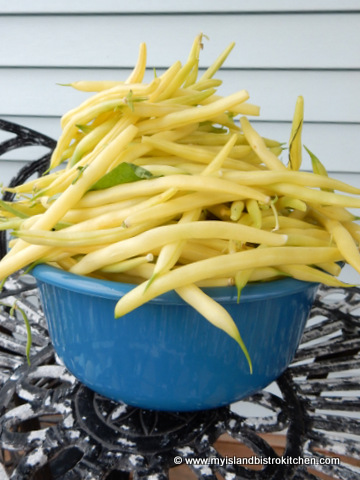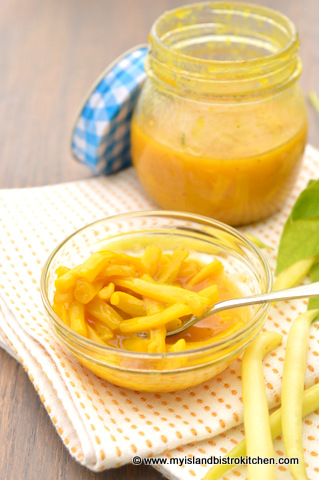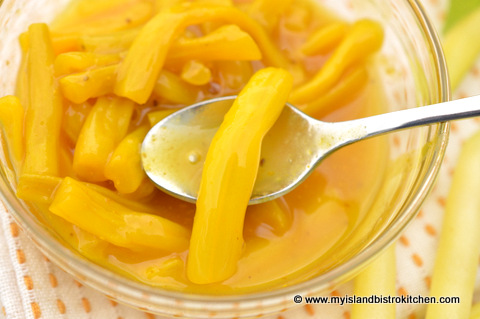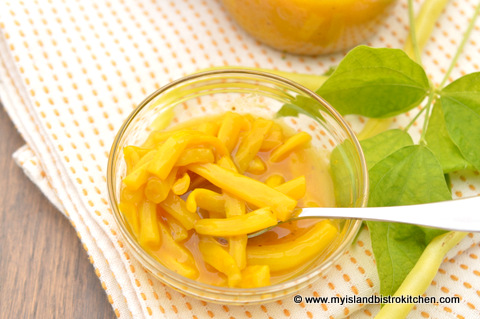We have had an abundance of yellow wax string beans this year. They were late producing but they sure made up for their tardiness.
We can only eat so many fresh beans so one way of preserving them is to make mustard beans. This is similar to mustard pickles which are made with cucumbers.
Mustard beans are actually quite easy and quick to make. The beans are par-cooked in boiling water, drained, then added to a mustard sauce . The trick is to cook the beans just until they are barely fork tender as, otherwise, they will become soggy and tough. The beans should still hold their shape but not be extremely hard when you bite into them.
Mustard beans are a great addition to many meals; we use them just like we would mustard pickles. They are simply a different texture and I make the mustard sauce a wee bit differently.
Mustard Beans
Ingredients:
1 lb yellow wax beans, cut into 1½” lengths (apx. 4 cups)
1½ – 2 cups boiling water
½ tsp table salt
1½ cups white vinegar
1 cup granulated sugar
1/3 cup brown sugar, lightly packed
¼ cup all-purpose flour
1½ tbsp dry mustard
½ tsp celery seed
1½ tsp turmeric
½ tsp. ground ginger
½ tsp table salt
Supplies and Equipment Needed:
4 half-pint glass canning jars for the mustard beans (plus 2-3 more half-pint-sized jars to take up extra space in the canner basket during the hot water bath process)
4 – two-piece lid and screw band sets (lids must be brand new and NOT previously used)
Medium-to-large sized, heavy-bottomed, stock pot for par-cooking beans and for making the mustard beans
Large colander for draining beans
Large pot for sterilizing jars
Small saucepan for heating jar lids
Large, heat-proof spoon for stirring beans
Water bath canner with basket
Jar lifter tongs
Wide-mouthed canning funnel
Large ladle or heat-proof glass measuring cup
Chopstick or small non-metallic heat-proof spatula to remove any air bubbles/air pockets from filled jars
Magnetic lid lifter
A timer
Clean cloth for wiping jar rims of filled jars
Method:
Wash jars in hot soapy water. Rinse. Fill a large-sized pot about two-thirds full of hot tap water. Place the jars, upright, into the water. Ensure the jars are fully submerged, each jar filled with water, and that the water is at least an inch over the tops of the jars, adding more if necessary. Cover, bring to a boil, and boil gently for 10 minutes. Turn off heat and leave the jars in the hot water to have ready to fill once the mustard beans are ready for bottling.
Fill the canner about half full of hot tap water. Cover and bring to a boil to have it ready for processing of the filled jars.
In medium-to-large sized heavy-bottomed pot and over medium-high heat, bring beans to a boil in salted water. Reduce heat to medium-low and par-cook beans just until they are barely fork tender. Drain in colander. Do not overcook or beans will become soft and mushy.
In the same medium-to-large sized pot in which the beans were par-cooked, heat 1 cup of the vinegar to the boiling point.
Combine sugars, flour, mustard, spices, and salt in bowl. Mix well. Add remaining 1/2 cup of vinegar to make a paste. Add and stir in 2-3 tablespoons of the hot vinegar to the mixture to temper it and then pour all the sauce ingredients into the hot vinegar in the pot. Cook sauce over medium-low heat until thickened, stirring frequently to prevent scorching. When sauce coats a spoon and drips off slowly, it is thick enough to add the par-cooked beans.
Add drained beans. Stir gently to coat beans with sauce. Heat beans over medium-low heat for about 5 minutes just to heat the beans. Gently stir beans constantly to prevent scorching. Do not overheat or overcook beans. Remove pot from heat.
Use jar lifter tongs to carefully remove the hot sterilized jars from the water, one at a time, emptying the water from the jars back into the pot. Drain jars well.
Using a large ladle, or a heat-proof glass measuring cup, and a wide-mouthed canning funnel, transfer mustard beans into the hot sterilized jars, leaving about ¼” headroom in each jar to allow for expansion during the hot water processing. Remove any trapped air bubbles in the jars with a chopstick or small heatproof, non-metallic spatula. Wipe the jar rims with a clean damp cloth to remove any stickiness or sauce particles that could prevent the lids from sealing properly to the jars.
Remove a small amount of the hot water from the stockpot in which the jars were sterilized and place in small saucepan over simmering heat. Place the lids in the hot water just long enough to heat them and to soften the rubber sealing compound. Do not boil the lids or leave in the hot water for an extended time.
Using a magnetic lid lifter, remove lids from the hot water and center the heated lids on jars so the sealing compound on the lid edges aligns with the jar rims. Fingertip tighten ring/screw bands on jars until resistance is encountered. Do not over-tighten.
Using jar lifter tongs, carefully place the hot filled jars upright in wire basket positioned in the canner, ensuring jars do not touch each other or fall over. Depending on the canner basket shape and design, it may be necessary to add some of the hot empty jars, upright, to the basket to fill up space so the filled jars do not topple over. Let the empty jars fill with water from the canner as they are submerged. Ensure the water level is at least 1” above the tops of jars, adding more boiling water as necessary. Cover with canner lid. Increase the heat to return the water to a full rolling boil then decrease the heat to just keep the water at a moderately rolling boil but not boiling over. Process jars in the hot water bath for 10 minutes, adjusting time as and if necessary for altitude. Start timing the processing from the point at which a full rolling boil is reached after jars have been added to the canner. At the end of the processing time, turn off heat and remove canner lid.
Let jars sit in the hot water for 5 minutes then, using jar lifter tongs, carefully remove the jars filled with the mustard beans, one at a time, and transfer them to a heat-proof cutting board, that has been covered with a towel to protect the board, to cool completely.
Listen for the “pop” or “ping” sound as the bottles seal over the next few minutes or hours. The lids of properly sealed jars will curve downward. Let jars rest, undisturbed, on counter for 24 hours. Then, test each jar for proper sealing by lightly pressing down on the center of each jar lid. If the lid is already pressed downward, and does not pop back up, it is properly sealed. Any jars that do not pass this test should be refrigerated and the mustard beans used within a week or so.
Store properly sealed bottles in cool, dark place. Refrigerate mustard beans once jar has been opened.
Yield: Apx. 4 half pints
—————————————————————————-
If you have made this recipe and enjoyed it and/or wish to share it with your friends and family, please do so on social media but be sure to share the direct link to this posting from my website.
Connect with “the Bistro” through the following social media:
Join My Island Bistro Kitchen on Facebook
Follow “the Bistro’s” tweets on Twitter
Follow “the Bistro” on Pinterest
Follow “the Bistro” on Instagram
——————————————————————————
For other great pickle and relish recipes from My Island Bistro Kitchen, click on the links below:
Mustard Pickles
Dill Pickles
Bread and Butter Pickles
Rhubarb Relish
Green Tomato Chow
Pickled Beets

Mustard Beans
Ingredients
- 1 lb yellow wax beans, cut into 1½” lengths (apx. 4 cups)
- 1½ – 2 cups boiling water
- ½ tsp table salt
- 1½ cups white vinegar
- 1 cup granulated sugar
- 1/3 cup brown sugar, lightly packed
- ¼ cup all-purpose flour
- 1½ tbsp dry mustard
- ½ tsp celery seed
- 1½ tsp turmeric
- ½ tsp. ground ginger
- ½ tsp table salt
Instructions
- Wash jars in hot soapy water. Rinse. Fill a large-sized pot about two-thirds full of hot tap water. Place the jars, upright, into the water. Ensure the jars are fully submerged, each jar filled with water, and that the water is at least an inch over the tops of the jars, adding more if necessary. Cover, bring to a boil, and boil gently for 10 minutes. Turn off heat and leave the jars in the hot water to have ready to fill once the mustard beans are ready for bottling.
- Fill the canner about half full of hot tap water. Cover and bring to a boil to have it ready for processing of the filled jars.
- In medium-to-large sized heavy-bottomed pot and over medium-high heat, bring beans to a boil in salted water. Reduce heat to medium-low and par-cook beans just until they are barely fork tender. Drain in colander. Do not overcook or beans will become soft and mushy.
- In the same medium-to-large sized pot in which the beans were par-cooked, heat 1 cup of the vinegar to the boiling point.
- Combine sugars, flour, mustard, spices, and salt in bowl. Mix well. Add remaining 1/2 cup of vinegar to make a paste. Add and stir in 2-3 tablespoons of the hot vinegar to the mixture to temper it and then pour all the sauce ingredients into the hot vinegar in the pot. Cook sauce over medium-low heat until thickened, stirring frequently to prevent scorching. When sauce coats a spoon and drips off slowly, it is thick enough to add the par-cooked beans.
- Add drained beans. Stir gently to coat beans with sauce. Heat beans over medium-low heat for about 5 minutes just to heat the beans. Gently stir beans constantly to prevent scorching. Do not overheat or overcook beans. Remove pot from heat.
- Use jar lifter tongs to carefully remove the hot sterilized jars from the water, one at a time, emptying the water from the jars back into the pot. Drain jars well.
- Using a large ladle, or a heat-proof glass measuring cup, and a wide-mouthed canning funnel, transfer mustard beans into the hot sterilized jars, leaving about ¼” headroom in each jar to allow for expansion during the hot water processing. Remove any trapped air bubbles in the jars with a chopstick or small heatproof, non-metallic spatula. Wipe the jar rims with a clean damp cloth to remove any stickiness or sauce particles that could prevent the lids from sealing properly to the jars.
- Remove a small amount of the hot water from the stockpot in which the jars were sterilized and place in small saucepan over simmering heat. Place the lids in the hot water just long enough to heat them and to soften the rubber sealing compound. Do not boil the lids or leave in the hot water for an extended time.
- Using a magnetic lid lifter, remove lids from the hot water and center the heated lids on jars so the sealing compound on the lid edges aligns with the jar rims. Fingertip tighten ring/screw bands on jars until resistance is encountered. Do not over-tighten.
- Using jar lifter tongs, carefully place the hot filled jars upright in wire basket positioned in the canner, ensuring jars do not touch each other or fall over. Depending on the canner basket shape and design, it may be necessary to add some of the hot empty jars, upright, to the basket to fill up space so the filled jars do not topple over. Let the empty jars fill with water from the canner as they are submerged. Ensure the water level is at least 1” above the tops of jars, adding more boiling water as necessary. Cover with canner lid. Increase the heat to return the water to a full rolling boil then decrease the heat to just keep the water at a moderately rolling boil but not boiling over. Process jars in the hot water bath for 10 minutes, adjusting time as and if necessary for altitude. Start timing the processing from the point at which a full rolling boil is reached after jars have been added to the canner. At the end of the processing time, turn off heat and remove canner lid.
- Let jars sit in the hot water for 5 minutes then, using jar lifter tongs, carefully remove the jars filled with the mustard beans, one at a time, and transfer them to a heat-proof cutting board, that has been covered with a towel to protect the board, to cool completely.
- Listen for the “pop” or “ping” sound as the bottles seal over the next few minutes or hours. The lids of properly sealed jars will curve downward. Let jars rest, undisturbed, on counter for 24 hours. Then, test each jar for proper sealing by lightly pressing down on the center of each jar lid. If the lid is already pressed downward, and does not pop back up, it is properly sealed. Any jars that do not pass this test should be refrigerated and the mustard beans used within a week or so.
- Store properly sealed bottles in cool, dark place. Refrigerate mustard beans once jar has been opened.
Recipe Notes
Yield: Apx. 4 half pints
Pin Me To Pinterest!
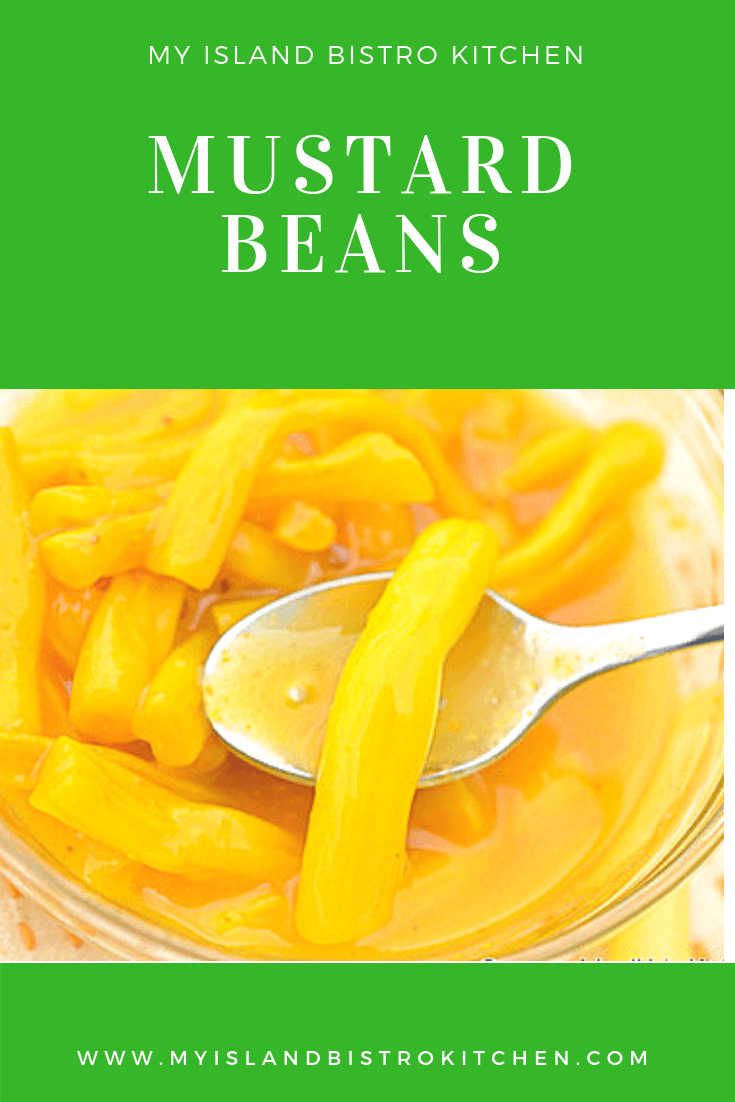
This post was last updated August 20, 2023

